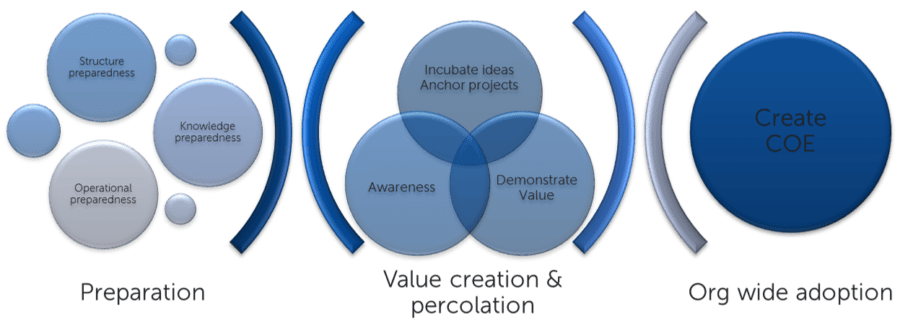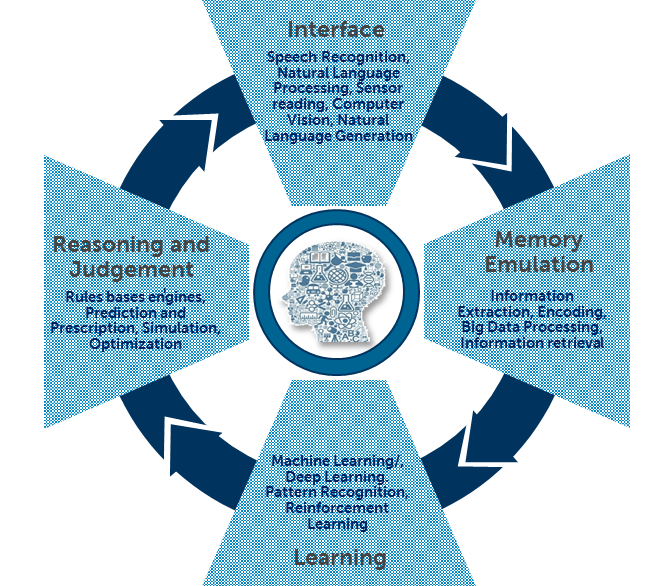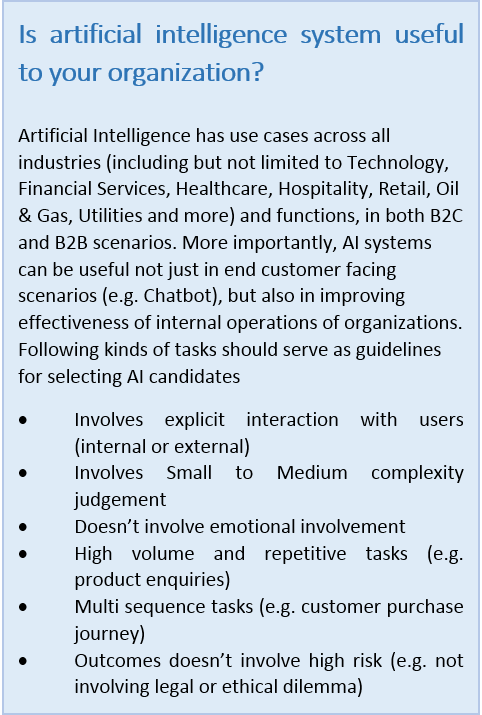Only Homo sapiens, of all the descendants of Homo erectus, survived on earth whereas other species such as homo soloensis, homo denisova, Homo neanderthalensis, Homo floresiensis faded away more than 40,000 years ago. What advantages did Homo sapiens possess that helped them to flourish while other species are extinct? Apparently a cognitive revolution (according to Prof. Yuval Harari in his famous book Sapiens) triggered by some kind of genetic mutation provided Homo Species with more cerebral power and thus they acquired an ability not possessed by any other species – ability to imagine things that did not exist. This ability helped them to invent things including powerful communicative languages, religion, tools and more.
Does current cognitive revolution ushered under various nomenclatures such as artificial intelligence, cognitive computing etc provide more powers, this time to machines and bring in unprecedented progress to human life? Are public and private institutions geared towards initiating, leading and supporting this change? How can leaders at private enterprises reap the benefit of AI and how do leaders at public organizations and government institutions create policies and regulations to handle issues arising from growing adoption of AI? It is imperative that leaders in these organizations are conscious of the latest developments in the field of artificial intelligence.
Current state of Artificial Intelligence Systems
Broadly two classes of AI systems exist. First category called Artificial General Intelligence systems also called as strong AI are supposed to mimic human beings on most aspects. Few systems that fall, attempting to rather, in this class are IBM Watson, Google Assistant and Apple Siri. These systems are not just complex to develop, their usage within an enterprise as well to general public are questionable and limited at best. Obviously these systems are still in research stage and the progress has been comparatively slow.
Other class of AI systems called Artificial Narrow Intelligence are supposed to solve a specific problem or useful in a specific kind of scenario. These systems are also called weak AI although an unfair nomenclature and doesn’t justify the complexity, practicality and usefulness involved. Language translators, intelligent chatbots that assist customers in purchase cycle, driverless cars, systems that automate a specific process or task within an enterprise fall under this category. These systems, than Artificial General Intelligence systems, carry better and practical hopes to be useful to organizations and to general public. Therefore, there has been a flurry of activity in this category and many startups have blossomed to build these systems.
Chicago based Narrative Science has built a product that can derive meaning from data and transform data into useful narratives like an analyst does. Mumbai based vPhrase is another startup in similar domain that aims to transform content creation using artificial intelligence. Idavatar is an interesting startup in the healthcare domain and brings emotional intelligence to provide patient care. Ubiquitous personal assistants, especially for mundane yet irritating tasks, has been favorite topic as well. x.ai is a startup that builds highly intelligent virtual assistant to schedules meetings.
This interest is manifested in market activity in terms of VC investment as well as acquisitions by bigger companies. According to CB Insights , number of deals in AI domain increased from 156 to 2012 to than 655 in 2016, more than 300% in just 4 years. In the same 4 year period, size of funding increased more than 8 times from $588 Million to $5 Billion. Companies such as Google, facebook, apple have been most active in acquiring artificial intelligence based capabilities whereas Data Collective, Khosla ventures, Intel capital have been most active VC investors recently.
All kinds of organization are expected to benefit from Artificial Intelligence. According to a research from Infosys , AI is expected to bring average 39% increase in revenue. Few industries such as technology, financial service, and healthcare are more advanced in their quest of AI than others such as Utilities. While most agree on benefits of AI, Economic Intelligence Unit research posits that most organizations are still in exploratory phase of the AI journey. There are multiple constraints for successful adoption of AI in an organization. Companies that have been using analytics in big way find it natural and easier to adopt AI as well given the have the technology and data infrastructure ready, along with many skills required for AI. Conversely companies with not so good analytics capabilities will find it difficult to start the AI journey. Another constraint is lack of understanding of what AI really is and what really constitutes an AI system. This lack of awareness limits creation of use cases in the organization and thus impedes buy-in from senior management.
What constitutes an artificial intelligence system?
Definitions of most technologies in the hype cycle usually gets diluted in quest of organizations to be forerunners in the topic. Before embracing artificial intelligence technology in the organization, it is important to get clarity on what really constitutes an artificial intelligence system. An AI system usually includes at least four key components.
Interface: Humans communicate to the outside world through various means – written and spoken language, vision and signs. Ergo, an AI system should also contain an interface to mimic this kind of a behavior for two way communication. Speech recognition in Apple Siri or Natural language Processing involved in Google translators are most common interfaces. Advanced AI systems such as robots might include more complex interfaces including sensory capabilities. Needlessly, the interface should be two way, for the AI system to communicate back to users. Natural Language generation, which is an evolving field within AI, helps AI systems to communicate back to humans in more natural way. Think of an AI system that write business performance summary of a company based on annual report and data from google finance.
Memory Emulation: AI systems cannot be transitory or stateless. AI should be able to emulate the memory function similar to that of humans. Human brain with nearly 100 billion neuron can supposedly hold up to 2.5 Petabytes of data. Advancement in storage systems, both in hardware, algorithms and frameworks (e.g. Hadoop), make processing of really big data easier and efficient. Similar to human brain, AI system should be able to gather data, extract relevant meanings, encode appropriately, store and finally retrieve information efficiently.
Learning: Most crucial part of an AI system that brings machines slightly closer to humans is continuous learning. How does a recommendation engine (though cannot be considered as full-fledged AI system) in eCommerce sites works? It uses humongous historical data on browsing and purchase behavior of website visitors, learns patterns in the data for product preferences and makes relevant product recommendations. This learning is not one time, but happens continuously (at regular intervals) whenever chunk of new data is available. In fact learning is a key component that differentiates current generation of AI systems from earlier generations (called expert systems). This advancement is made possible mainly because of prevalence of machine learning algorithms. For example, recently Google announced that its language translation tool is dramatically improved because of using a versatile machine learning technique called Deep Learning (which is designed to mimic brain’s neural networks).
Reasoning and Judgement: This component is where two other components, memory and Learning, are utilized to act like humans do. For instance, consider a chatbot that recommends laptops to online visitors. Historical data can be used to learn patterns in customer preferences (part of learning component). Here previous learning is used to make judgement on what laptops might be liked by the current customer. This component might also use simulation and optimization algorithms to weigh in multiple solutions and decide optimal course of action. This component brings hope to automate advanced tasks such as planning and judgement that humans can do.
How to effectively adopt Artificial Intelligence in the organization
As in the case with most of the innovative and forward looking technologies, particularly those in very initial stages of development, AI as well faces multiple challenges for successful adoption in the organization. Effective adoption, therefore, involves resolving those challenges. If you are confused whether Artificial Intelligence is really useful to your organization, please see the box below. Once you decide to adopt AI, following steps might be right guidelines to use.

Preparation
- Structure preparedness: Current wave of AI growth is largely because of availability of big data, innovation in technology and development of effective machine learning algorithms. Therefore, it all makes sense to entrust existing analytics division in the organization to host and initiate AI journey. Initiatives like this also requires a champion who will spearhead all the tasks towards AI preparedness. AI champion who is expected to be a senior level leader should be able to think and work seamlessly across functions. It also helps to create informal employee forum. These employees should cover various expertise needed to build an AI system – Data scientists who can build predictive models, Natural Language Processing Experts, Image processing experts, Big Data architects etc.
- Cultural and knowledge preparedness: Create awareness across hierarchies of the organization. Establish the feeling that AI is not just an esoteric and futuristic technology, but can be of practical use to the organization as well. This can be done through various sessions with targeted audience, both within and outside the analytics team, across hierarchies and functions. Use case studies how other companies in the same industry or outside are as well as potential use cases in your organization. Also review legal and ethical implications of AI systems.
- Operational preparedness: AI Champion needs to create charter, guidelines and processes towards effective AI journey. Until the business value is acknowledged and investment decision is made, this will remain forward looking initiative without dedicated resources. Therefore guidelines and processes should ensure current works of the organization are not disrupted. Further work such a building prototypes require infrastructure support as well. Borrow required hardware and software tools within the existing analytics division.
Value Creation and Percolation
Gather initial ideas from experts in the informal employee forum. Research on those ideas and create one or two anchor projects. These anchor projects should be of easy to medium level complexity, should be impactful, which can be created in a short timeframe. Use employee forum to execute these anchor projects and develop either prototype AI systems. Assess and clearly articulate the business benefits from these anchor projects. Ensure to communicate the benefits back to targeted audience.
Organization Wide Adoption
Once senior leadership is convinced with benefits from AI and are ready to make investment and sponsor AI projects, consider creating a Center Of Excellence within the existing analytics division. AI is expected to play transformative role and its longevity in organizations is unquestionable. Therefore, investing in AI focused COE is strategically important. This COE can work on one of the two models. One, it can be a centralized place to develop all AI systems. Second, while other functions within analytics can execute relevant AI projects, COE can govern and support those projects. COE should also be forward looking and slightly research oriented, continuing to take initiatives for developing AI systems in the organization.
Author: Amith Parameshwara is a Principal in the analytics division of Dell EMC. Views expressed are his own and not represent the companies he is working currently or worked earlier. He has nearly 17 years of experience in the technology industry across diverse functions and domains including analytics. He can be contacted at [email protected] or @Analytics_Dhi


